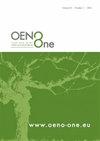Chitosan and its applications in oenology
IF 2.2
3区 农林科学
Q3 FOOD SCIENCE & TECHNOLOGY
引用次数: 0
Abstract
This paper reviews the main applications of the biopolymer chitosan, the main derivative of chitin, a material usually obtained from natural sources accessible at low cost, i.e., industrial wastes from fisheries. Due to its natural origin, which confers biodegradability and biocompatibility properties, in addition to its low toxicity, chitosan has been gaining attention in numerous sectors, such as agriculture, food, medicine, pharmaceuticals, etc., including also important oenological applications due to its potential as a green alternative to the use of sulphite. Among the many applications that can be generated from these materials in the wine-making area, their use has been reported for the clarification of must; in the preparation of films for the removal of contaminants, whether organics such as ochratoxin A or inorganics such as some metal ions and their salts; the control of turbidity caused by protein precipitation; the encapsulation of yeasts of oenological interest and enzymes for the control of adverse microorganisms such as Brettanomyces; the manufacture of sensors and nanosensors for the quantification of contaminants, the quality control of starting materials and final products, the optimisation of fermentation processes, the monitoring of storage conditions, etc. As a result of this review, significant development of the applications of this material in the oenological area can be expected, especially due to the possibilities of preparing new derivatives, including the great variety of these that have been recently proposed through click reactions, as well as the growing incursion of chitosan in nanobiotechnology.壳聚糖及其在酿酒学中的应用
本文综述了生物聚合物壳聚糖的主要应用,壳聚糖是甲壳素的主要衍生物,通常从低成本的天然来源获得,即渔业工业废物。由于其天然来源,具有生物降解性和生物相容性,除了低毒性外,壳聚糖在农业、食品、医药、制药等众多领域也受到了关注,包括重要的酿酒应用,因为它有可能成为亚硫酸盐的绿色替代品。在酿酒领域中,这些材料可以产生许多应用,据报道,它们的用途是澄清必须;在制备用于去除污染物的膜时,无论是有机物如赭曲霉毒素A还是无机物如某些金属离子及其盐;控制蛋白质沉淀引起的浊度;具有酿酒学意义的酵母和用于控制不良微生物(如Brettaomyces)的酶的包封;用于污染物定量的传感器和纳米传感器的制造、原料和最终产品的质量控制、发酵过程的优化、储存条件的监测等。由于这一综述,预计这种材料在酿酒领域的应用将有重大发展,特别是由于制备新衍生物的可能性,包括最近通过点击反应提出的各种衍生物,以及壳聚糖在纳米生物技术中的日益渗透。
本文章由计算机程序翻译,如有差异,请以英文原文为准。
求助全文
约1分钟内获得全文
求助全文
来源期刊

OENO One
Agricultural and Biological Sciences-Food Science
CiteScore
4.40
自引率
13.80%
发文量
85
审稿时长
13 weeks
期刊介绍:
OENO One is a peer-reviewed journal that publishes original research, reviews, mini-reviews, short communications, perspectives and spotlights in the areas of viticulture, grapevine physiology, genomics and genetics, oenology, winemaking technology and processes, wine chemistry and quality, analytical chemistry, microbiology, sensory and consumer sciences, safety and health. OENO One belongs to the International Viticulture and Enology Society - IVES, an academic association dedicated to viticulture and enology.
 求助内容:
求助内容: 应助结果提醒方式:
应助结果提醒方式:


